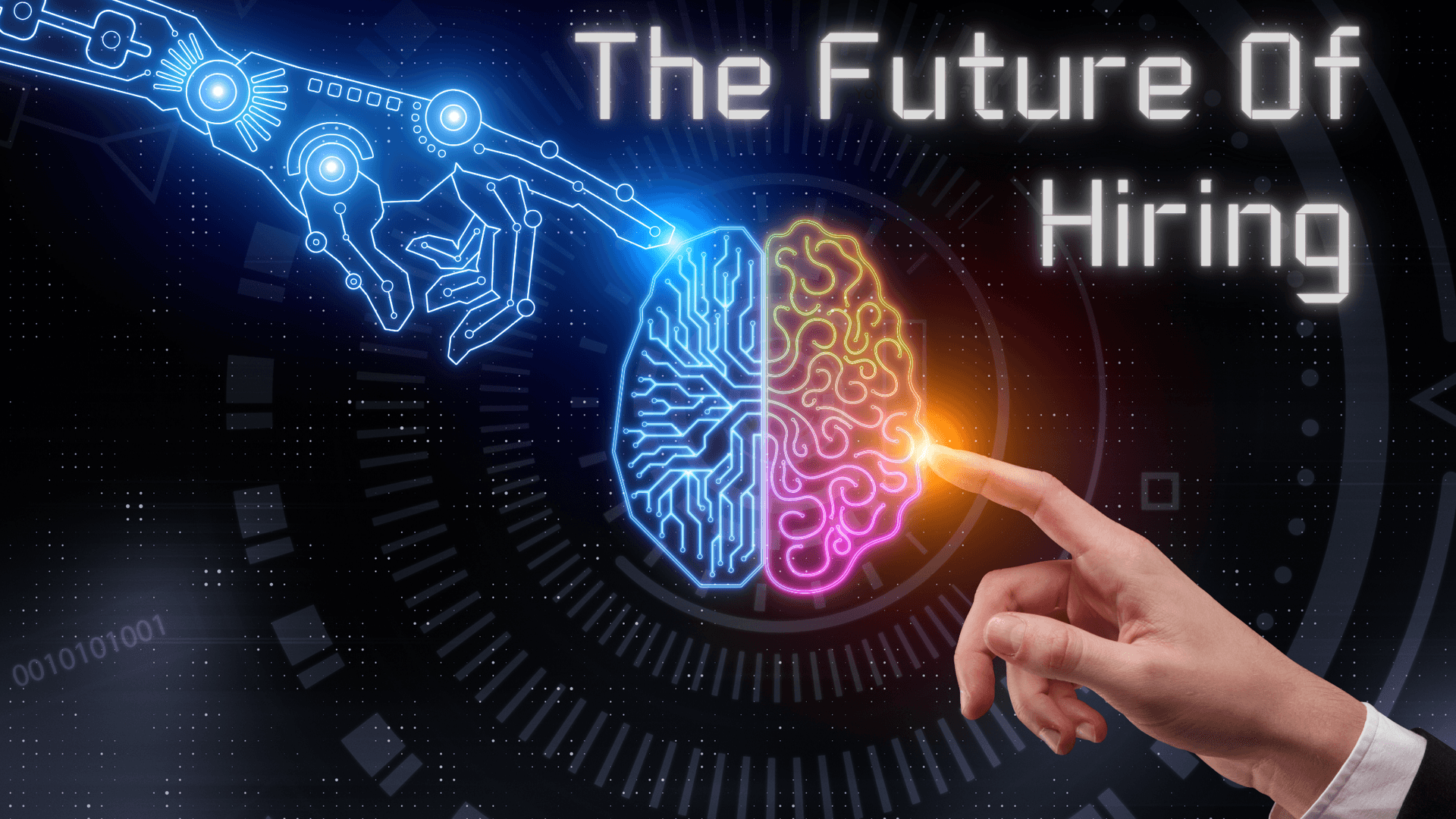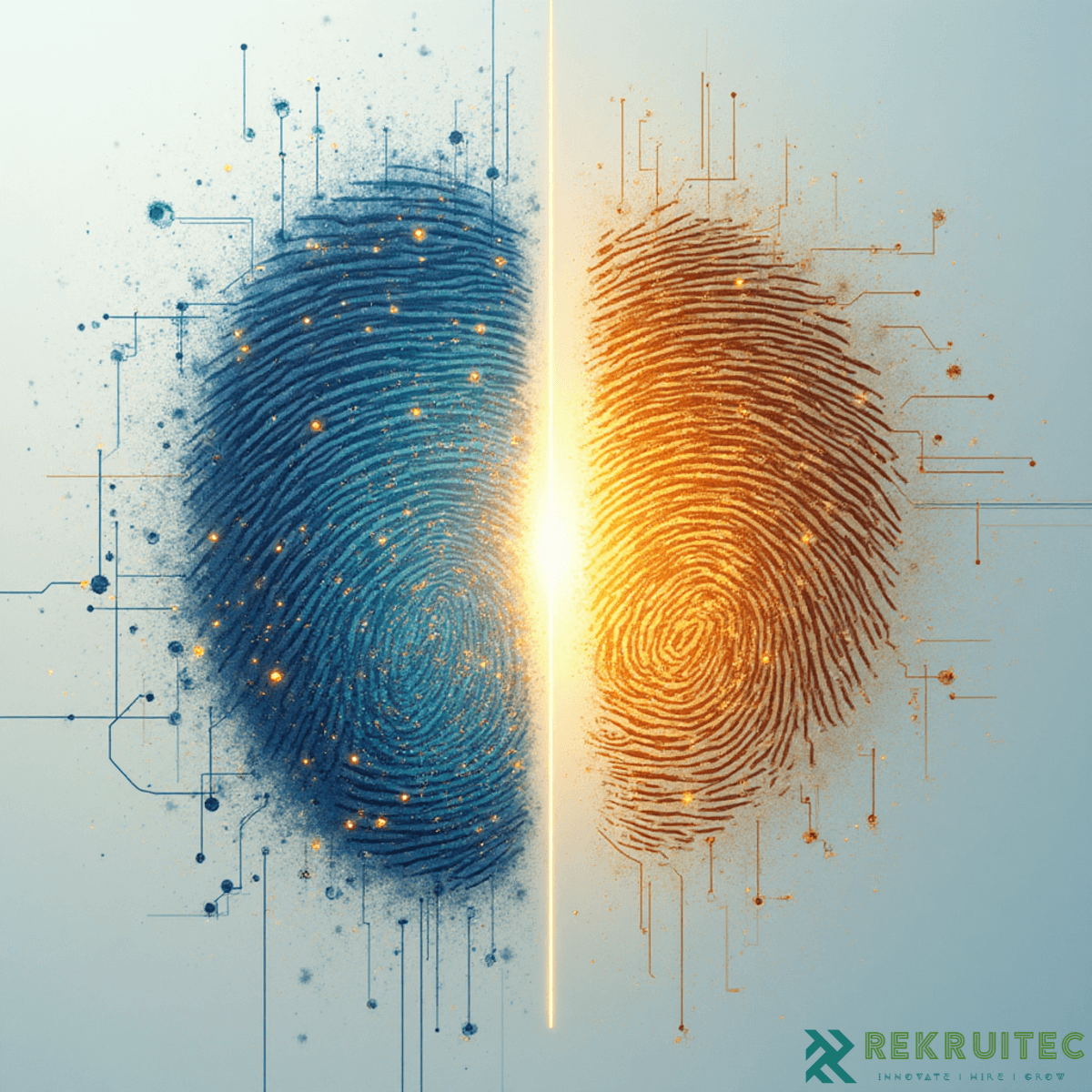The Future Of Recruitment is Hybrid: Half AI, Half Intuition
In the era of “talent wars”, companies are under pressure to move fast, hire well and build culture. On one side, we have artificial intelligence - capable of screening thousands of profiles in seconds, predicting job-fit, analysing tone, even assessing personality traits. On the other side, we have human intuition - the recruiter who sees more than data, senses potential, reads energy, decodes unspoken ambition.
The smartest organisations are forging a hybrid model: AI for volume, speed and insight; humans for empathy, connection and judgement.
Here’s why that balance matters, what the data shows, and how you can apply it in your hiring process.

1. Why AI matters - the “half AI” side
There’s no denying that AI has become a major force in recruitment. Some of the key trends:
According to one source, a 2024 surge in AI tools for recruitment showed a 68.1% increase in use compared to the previous year, with 60% of organisations saying they now use AI to manage talent.
Another survey reports that “between 35% and 45% of companies have now adopted AI in their hiring processes”, and the AI recruitment sector is projected to grow at 6.17% compound annual growth rate (2023-2030).
In 2024, 87% of companies reportedly incorporate AI into recruitment in some way; but only 8% are using it end-to-end.
What AI brings to the table:
- Speed & scale: It can sort, screen, parse thousands of applications far faster than humans.
- Pattern recognition: Algorithms can detect correlations in candidate data, extract keywords, match skills.
- Consistency & data-driven decisions: AI helps reduce variability in process.
- Freeing up human bandwidth: By automating screening and scheduling, recruiters can spend more time on higher-value tasks.
In short: AI enables recruitment at scale, reduces administrative burden, improves efficiency. But… it’s only part of the answer.
2. Why human intuition still matters - the “half intuition” side
Despite the gains from AI, research underscores that intuition and human‐judgement continue to play a critical role
A study in the Journal of Management & Organization (2024) found that interviewer expertise increases the quality of intuitive hiring decisions for complex jobs — i.e., when roles are ambiguous and predictors of performance are hard to pin down, intuition from experts helps.
On the qualitative side, human recruiters bring: empathy, context sensitivity, cultural judgement, ability to read the “unknown unknowns”. For example: they can sense when a candidate “lights up” talking about their craft, or detect quiet confidence in someone shifting careers.
AI is often trained on historical data (past job titles, specific keywords). Humans excel at seeing beyond the resume - identifying a candidate from a different industry who has the core problem-solving skills or leadership qualities to excel.
Why this human piece still matters:
Human intuition is critical for spotting high-potential candidates and transferable skills. While an AI might filter out a candidate who lacks a specific keyword or a conventional career path, a human recruiter can connect the dots. They can see how a project manager from the non-profit world has the stakeholder management and grit to succeed in a tech startup, or how a teacher's communication and organizational skills are perfect for a customer success role. This ability to see what a candidate could become is a uniquely human advantage, especially for innovative or evolving roles."
- Soft skills, culture-fit and motivation are hard to quantify with algorithms alone.
- Candidate experience matters: how you treat candidates matters for your employer brand - human touch is hard to replicate with bots.
3. Why “AI vs Humans” is the wrong framing
A common trap is to treat this as a competition: “Will AI replace recruiters?” The better framing: How do we enable recruiters through AI, rather than replace them with AI?
Here are three key reasons to embrace the hybrid mindset:
- Neither alone is sufficient: AI lacks empathy, intuition, the ability to read potential. Humans without technology struggle with scale and speed.
- Complementarity: Use AI for what it’s best at (data, screening, speed) and humans for what we’re uniquely good at (connection, judgement, nuance).
- Better outcomes: The future of recruitment isn’t about feeling threatened by AI, it’s about being powered by it. According to a 2025 survey, even though 99% of hiring managers reported using AI, 93% still say “human involvement remains essential”.

4. What this means in practice - for startups, SMEs and talent leaders
If you buy into the hybrid model, what should you do differently? Here are actionable steps:
- Automate the Routine, Elevate the Human: Clearly define AI's role for high-volume, repetitive tasks (screening, scheduling). This frees up human recruiters to focus on strategic conversations: interviewing, assessing culture-fit, and making the final hiring decision.
- Train Recruiters to be AI-Savvy: Recruiters must become proficient at interpreting AI output. This means not just accepting the "top 10%" of candidates, but understanding why the AI ranked them that way. Empower them to challenge the algorithm and make an override decision based on human judgment.
- Build Balanced Metrics: Track AI-driven efficiency gains (time-to-fill, cost-per-hire) alongside human-centric quality metrics (quality of hire, retention rates, candidate satisfaction scores).
- Guard Against AI Bias from Day One: Implement human oversight as a built-in check against algorithmic bias. Regularly audit your AI's recommendations for fairness across demographics. Remember, AI can amplify human biases present in your historical hiring data.
Here is a breakdown of how AI bias happens, followed by a concrete, famous example.
How It Happens: The "Garbage In, Garbage Out" Principle
AI models, particularly those used for recruitment, learn to make decisions by finding patterns in historical data. If that historical data contains human biases, the AI will not only learn those biases but can also codify and scale them with terrifying efficiency.
- The AI's Goal: The AI is trained to identify candidates who "look like" your past successful hires. It doesn't have a moral compass; it has a correlation engine.
- The Flawed Data: If your company has historically hired mostly men for tech roles, or mostly leading university graduates, the AI learns that "being male" or "graduating from a leading school/college" are strong predictors of success.
- The Amplification: A human recruiter might have a biased preference but can occasionally make an exception. The AI, however, systematically and consistently downgrades every single candidate who doesn't fit the biased profile, across thousands of applications, without fatigue or second thoughts.

Proven Example: The Amazon Case Study
This is the most famous real-world example of this failure mode, extensively reported by Reuters and other outlets.
The Goal: Amazon, a leader in AI, built an experimental recruiting tool to automate the search for top talent. The goal was to review resumes and score candidates from 1 to 5 stars.
The Data: The AI was trained on resumes submitted to Amazon over a 10-year period. The vast majority of these resumes came from men, reflecting the male-dominated tech industry.
The Bias Amplification in Action:
The AI learned to penalize resumes that included the word "women's" (e.g., "women's chess club captain"). It penalized graduates of all-women's colleges.
It downgraded candidates who listed women-centric affiliations or hobbies.
The system taught itself that male candidates were preferable. It did this by identifying patterns in the wording of resumes. Since the historical data showed that men were hired more frequently, the AI inferred that language and experiences more common on male applicants' resumes were more desirable.
The Outcome:
Amazon's engine did not just reflect the past bias; it actively amplified it. The tool was systematically discriminating against female candidates. The company eventually scrapped the project because they could not guarantee the algorithm would become neutral.
Why This is "Amplification" and Not Just "Reflection":
A human recruiter with an unconscious bias might let one or two qualified female candidates through. Amazon's AI, tasked with reviewing millions of resumes, would have filtered out all female candidates who didn't mask their gender, at a scale and speed no human team could match.
Have AI Models Evolved Since to Not Make Such Biases?
This is the central question, and the answer is nuanced: Yes, the technology and awareness have evolved significantly, but the fundamental problem is not "solved." Bias is not a bug that has been patched; it's a core risk that must be actively and constantly managed.
The Conclusion for Recruiters
This proves that AI is not an objective panacea. Its "objectivity" is entirely dependent on the quality and fairness of the data it's trained on. Without careful design, auditing, and human oversight, an AI recruitment tool can very quickly and systematically exclude entire demographics of qualified candidates, turning historical, small-scale human biases into a large-scale, automated discriminatory system.
This is precisely why the hybrid model is essential: the human role is to provide the ethical oversight, to constantly question the AI's recommendations, and to look for the potential the algorithm might have missed.
5. Future outlook: “Half AI, Half Intuition”
What does recruitment look like in the next 3–5 years? Here are some predictions:
- Hybrid workflows will be standard: The companies that separate AI from humans will fall behind. Those that integrate seamlessly will have an edge.
- Skills-based hiring and adaptable roles will rise: As one study shows, firms are moving from degree-requirements to skills-based hiring - signalling a need for human judgement in identifying potential beyond credentials.
- Candidate expectations will shift: Candidates will expect faster, more transparent processes, personalised communication, and clearer feedback (areas where humans can deliver).
- Ethics, transparency and fairness will become front-of-mind: Because AI tools can introduce bias, human oversight will be key. Hybrid models allow checks and balances.
- Recruiters will evolve into talent strategists: With AI handling tactical loads, human recruiters will spend more time on strategy: employer brand, team fit, talent pipelines.
6. Final thoughts
If your hiring process still runs entirely on manual spreadsheets and gut-decisions, you’re missing the advantage of scale and data. If your process is entirely automated, you risk losing the heart of recruitment: human connection, judgement and culture.
The future is not AI vs humans. It is AI Enabled, Powered By Human Expertise.
- Use AI to filter noise, analyse data, increase speed.
- Use humans to sense potential, build relationships, ask the right questions.
Recruitment isn’t becoming robotic - it’s becoming smarter.
In this evolving landscape, the organisations that win the talent war will be those who master the hybrid model: equipping human recruiters with AI, trusting intuition where data falls short, and constantly iterating the balance. That’s how you build not just a team, but the right team.

